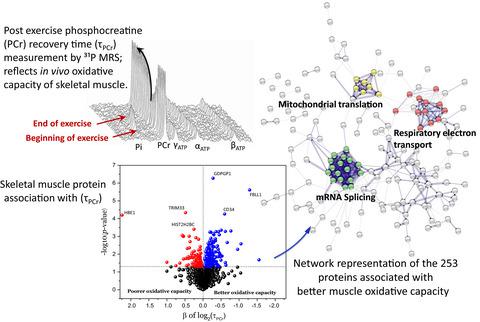当前位置:
X-MOL 学术
›
Aging Cell
›
论文详情
Our official English website, www.x-mol.net, welcomes your
feedback! (Note: you will need to create a separate account there.)
Proteomic signatures of in vivo muscle oxidative capacity in healthy adults.
Aging Cell ( IF 8.0 ) Pub Date : 2020-03-20 , DOI: 10.1111/acel.13124 Fatemeh Adelnia 1, 2 , Ceereena Ubaida-Mohien 1 , Ruin Moaddel 3 , Michelle Shardell 1 , Alexey Lyashkov 3 , Kenneth W Fishbein 3 , Miguel A Aon 1 , Richard G Spencer 3 , Luigi Ferrucci 1
Aging Cell ( IF 8.0 ) Pub Date : 2020-03-20 , DOI: 10.1111/acel.13124 Fatemeh Adelnia 1, 2 , Ceereena Ubaida-Mohien 1 , Ruin Moaddel 3 , Michelle Shardell 1 , Alexey Lyashkov 3 , Kenneth W Fishbein 3 , Miguel A Aon 1 , Richard G Spencer 3 , Luigi Ferrucci 1
Affiliation

|
Adequate support of energy for biological activities and during fluctuation of energetic demand is crucial for healthy aging; however, mechanisms for energy decline as well as compensatory mechanisms that counteract such decline remain unclear. We conducted a discovery proteomic study of skeletal muscle in 57 healthy adults (22 women and 35 men; aged 23–87 years) to identify proteins overrepresented and underrepresented with better muscle oxidative capacity, a robust measure of in vivo mitochondrial function, independent of age, sex, and physical activity. Muscle oxidative capacity was assessed by 31P magnetic resonance spectroscopy postexercise phosphocreatine (PCr) recovery time (τPCr) in the vastus lateralis muscle, with smaller τPCr values reflecting better oxidative capacity. Of the 4,300 proteins quantified by LC‐MS in muscle biopsies, 253 were significantly overrepresented with better muscle oxidative capacity. Enrichment analysis revealed three major protein clusters: (a) proteins involved in key energetic mitochondrial functions especially complex I of the electron transport chain, tricarboxylic acid (TCA) cycle, fatty acid oxidation, and mitochondrial ABC transporters; (b) spliceosome proteins that regulate mRNA alternative splicing machinery, and (c) proteins involved in translation within mitochondria. Our findings suggest that alternative splicing and mechanisms that modulate mitochondrial protein synthesis are central features of the molecular mechanisms aimed at maintaining mitochondrial function in the face of impairment. Whether these mechanisms are compensatory attempt to counteract the effect of aging on mitochondrial function should be further tested in longitudinal studies.
中文翻译:

健康成年人体内肌肉氧化能力的蛋白质组学特征。
对生物活动和高能需求波动期间的能量充分支持对健康老龄化至关重要;但是,能量下降的机制以及抵消这种下降的补偿机制仍不清楚。我们对57位健康的成年人(22位女性和35位男性;年龄在23-87岁)的骨骼肌进行了蛋白质组学发现研究,以鉴定蛋白质代表的过高和代表不足,具有更好的肌肉氧化能力,这是体内线粒体功能的有力衡量指标,与年龄无关,性别和体育锻炼。肌肉氧化能力被评估31 P磁共振波谱运动后磷酸肌酸(PCR)恢复时间(τ的PCr)在股外侧肌,与τ小肌酸反映更好的氧化能力的值。通过LC-MS在肌肉活检中定量的4,300种蛋白质中,有253种明显被过分代表,具有更好的肌肉氧化能力。富集分析揭示了三个主要的蛋白质簇:(a)参与关键的高能线粒体功能的蛋白质,尤其是电子传输链的复杂I,三羧酸(TCA)循环,脂肪酸氧化和线粒体ABC转运蛋白;(b)调节mRNA选择性剪接机制的剪接体蛋白,以及(c)线粒体内参与翻译的蛋白。我们的发现表明,选择性剪接和调节线粒体蛋白质合成的机制是旨在在受损情况下维持线粒体功能的分子机制的主要特征。
更新日期:2020-03-20
中文翻译:

健康成年人体内肌肉氧化能力的蛋白质组学特征。
对生物活动和高能需求波动期间的能量充分支持对健康老龄化至关重要;但是,能量下降的机制以及抵消这种下降的补偿机制仍不清楚。我们对57位健康的成年人(22位女性和35位男性;年龄在23-87岁)的骨骼肌进行了蛋白质组学发现研究,以鉴定蛋白质代表的过高和代表不足,具有更好的肌肉氧化能力,这是体内线粒体功能的有力衡量指标,与年龄无关,性别和体育锻炼。肌肉氧化能力被评估31 P磁共振波谱运动后磷酸肌酸(PCR)恢复时间(τ的PCr)在股外侧肌,与τ小肌酸反映更好的氧化能力的值。通过LC-MS在肌肉活检中定量的4,300种蛋白质中,有253种明显被过分代表,具有更好的肌肉氧化能力。富集分析揭示了三个主要的蛋白质簇:(a)参与关键的高能线粒体功能的蛋白质,尤其是电子传输链的复杂I,三羧酸(TCA)循环,脂肪酸氧化和线粒体ABC转运蛋白;(b)调节mRNA选择性剪接机制的剪接体蛋白,以及(c)线粒体内参与翻译的蛋白。我们的发现表明,选择性剪接和调节线粒体蛋白质合成的机制是旨在在受损情况下维持线粒体功能的分子机制的主要特征。











































 京公网安备 11010802027423号
京公网安备 11010802027423号